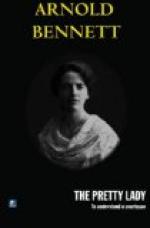Lady Queenie’s apartments did violence to G.J.’s sensibilities as an upholder of traditionalism in all the arts, of the theory that every sound movement in any art must derive from its predecessor. Some months earlier he had met for a few minutes the creative leader of the newest development in internal decoration, and he vividly remembered a saying of the grey-haired, slouch-hatted man: “At the present day the only people in the world with really vital perceptions about decoration are African niggers, and the only inspiring productions are the coloured cotton stuffs designed for the African native market.” The remark had amused and stimulated him, but he had never troubled to go in search of examples of the inspiring influence of African taste on London domesticity. He now saw perhaps the supreme instance lodged in Lechford House, like a new and truculent state within a great Empire.
Lady Queenie had imposed terms on her family, and under threats of rupture, of separation, of scandal, Lady Queenie’s exotic nest had come into existence in the very fortress of unchangeable British convention. The phenomenon was a war phenomenon due to the war, begotten by the war; for Lady Queenie had said that if she was to do war-work without disaster to her sanity she must have the right environment. Thus the putting together of Lady Queenie’s nest had proceeded concurrently with the building of national projectile factories and of square miles of offices for the girl clerks of ministries and departments of government.
The footman left G.J. alone in a room designated the boudoir. G.J. resented the boudoir, because it was like nothing that he had ever witnessed. The walls were irregularly covered with rhombuses, rhomboids, lozenges, diamonds, triangles, and parallelograms; the carpet was treated likewise, and also the upholstery and the cushions. The colourings of the scene in their excessive brightness, crudity and variety surpassed G.J.’s conception of the possible. He had learned the value of colour before Queen was born, and in the Albany had translated principle into practice. But the hues of the boudoir made the gaudiest effects of Regency furniture appear sombre. The place resembled a gigantic and glittering kaleidoscope deranged and arrested.
G.J.’s glance ran round the room like a hunted animal seeking escape, and found no escape. He was as disturbed as he might have been disturbed by drinking a liqueur on the top of a cocktail. Nevertheless he had to admit that some of the contrasts of pure colour were rather beautiful, even impressive; and he hated to admit it. He was aware of a terrible apprehension that he would never be the same man again, and that henceforth his own abode would be eternally stricken for him with the curse of insipidity. Regaining somewhat his nerve, he looked for pictures. There were no pictures. But every piece of furniture was painted with primitive sketches of human figures, or of flowers, or of vessels, or of animals. On the front of the mantelpiece were perversely but brilliantly depicted, with a high degree of finish, two nude, crouching women who gazed longingly at each other across the impassable semicircular abyss of the fireplace; and just above their heads, on a scroll, ran these words:




